
Mission San Antonio de Padua is a Spanish mission established by the Franciscan order in present-day Monterey County, California, near the present-day town of Jolon. Founded on July 14, 1771, it was the third mission founded in Alta California by Father Presidente Junípero Serra. The mission was the first use of fired tile roofing in Upper California. Today the mission is a parish church of the Diocese of Monterey and is no longer active in the mission work which it was set up to provide.

Anthony of Padua, OFM or Anthony of Lisbon was a Portuguese Roman Catholic priest and friar of the Franciscan Order.
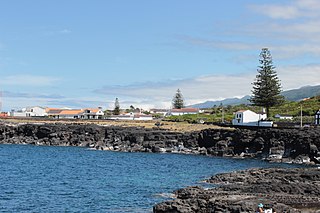
Santo António is a civil parish in the municipality of São Roque do Pico on the northern coast of the island of Pico in the Portuguese archipelago of the Azores. The population in 2011 was 815 in an area of approximately 32.03 square kilometres (12.37 sq mi).

Unión de San Antonio is a town and municipality located in the Mexican state of Jalisco. It is named after Saint Anthony of Padua since the first church built there was in his honor. As of 2005, the municipality had a population of 15,484. It is located about 32 km (20 mi) west of León, Guanajuato. The main local industry is agriculture, including maize, wheat, beans, and livestock.

Morcín is a municipality in the Autonomous Community of the Principality of Asturias, Spain. It is bordered on the north by Santo Adriano and Ribera de Arriba, on the east by Ribera and Mieres, on the south by Riosa on the west by Quirós.
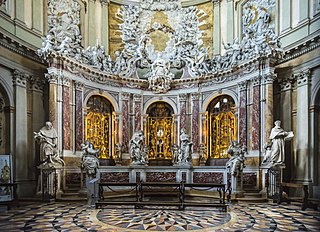
Filippo Parodi was an Italian sculptor of the Baroque period, "Genoa's first and greatest native Baroque sculptor".
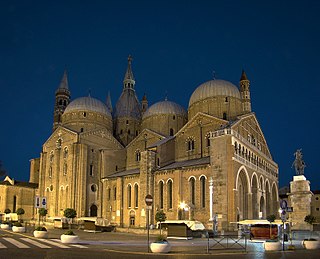
The Pontifical Basilica of Saint Anthony of Padua is a Catholic church and minor basilica in Padua, Veneto, Northern Italy, dedicated to St. Anthony of Padua.

San Antonio de Padua, or plainly Padua, is a city in the Greater Buenos Aires, in Argentina. It is located in Merlo Partido. The city has an area of 6.25 km2 (2 sq mi) and a population of around 38,000.

San Francesco della Vigna is a Roman Catholic church in the Sestiere of Castello in Venice, northern Italy.

The Church of Saint Anthony of Lisbon is a Roman Catholic church located in Lisbon, Portugal. It is dedicated to Saint Anthony of Lisbon. According to tradition, the church was built on the site where the saint was born, in 1195. The church is classified as a National Monument.

Palazuelos de Eresma is a municipality located in the province of Segovia, Castile and León, Spain. It takes its name from the River Eresma.
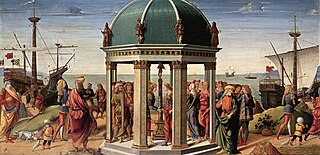
Biagio d’Antonio Tucci was an Italian Renaissance painter active in Florence, Faenza and Rome.

Santo António dos Olivais, commonly shortened to Olivais, is an urban civil parish in the municipality of Coimbra in Portugal, making up the eastern part of the historic city of Coimbra, east of University Hill. The population in 2011 was 38,936, in an area of 19.27 km². It is the most populated parish in the Municipality of Coimbra, and among the most densely inhabited in the country outside of Lisbon and Porto metropolitan areas. Created in 1836, the parish was named for Anthony of Padua, who joined the local branch of the Order of Friars Minor; Anthony took his name from Saint Anthony the Great, to whom the local Franciscan hermitage was dedicated.

The Hermitage of San Antonio de Padua de la Tuna is an archaeological site located near the Guajataca River in Coto, Isabela, Puerto Rico, dating from 1730. It comprises the ruins of a village church that was abandoned in the early 19th century when the community, with the permission of Governor Salvador Meléndez, moved to a more favorable location nearer the coast, which became the modern town of Isabela, founded in 1819.

The Royal Chapel of St. Anthony of La Florida is a Neoclassical chapel in central Madrid. The chapel is best known for its ceiling and dome frescoes by Francisco Goya. It is also his final burial place.
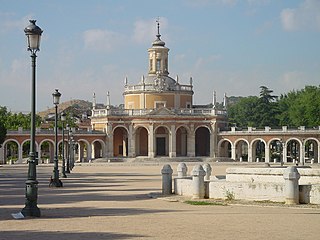
The Church of San Antonio is a church located in Aranjuez, in the Community of Madrid, Spain. It was declared Bien de Interés Cultural and a World Heritage Site by UNESCO within Aranjuez Cultural Landscape in 2003.

The Convento de San Antonio de Padua is a Franciscan convent located in Toledo, Castile-La Mancha, Spain. Dedicated to St Anthony of Padua, the institution was created in 1525 in the former palace of the advisor comunero Don Fernando de Ávalos, confiscated by order of Charles V, Holy Roman Emperor because its owner was a comunero. The entrance is Gothic-Mudéjar of the 15th Century.

The Vision of Saint Anthony of Padua is a 1656 oil on canvas painting by Bartolomé Esteban Murillo, commissioned by the chapter of Seville Cathedral as the altarpiece for its chapel of Saint Anthony of Padua, where it still hangs. It replaced an altarpiece by Bernardo Simón de Pineda.
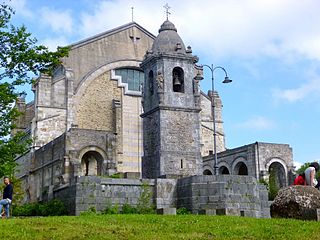
The Sanctuary of Saint Anthony the Abbot and Saint Anthony of Padua of Urkiola is a Catholic temple located in the hill and port of Urkiola, in the Biscayan municipality of Abadiño, in the Basque Country, Spain. It is unknown exactly how old the Sanctuary is, but according to some documents, it could have been between the 8th and 11th centuries, making it one of the oldest of the region. It is located at the heart of the Urkiola Natural Park, next to one of the historical routes linking the Cantabrian coast with the Castilian plateau and surrounded by a lush nature in which the limestone walls of the mountains of Durangaldea stand out as a background, with the Anboto as the highest altitude, where Basque mythology places the main dwelling of its highest deity, Mari.





















